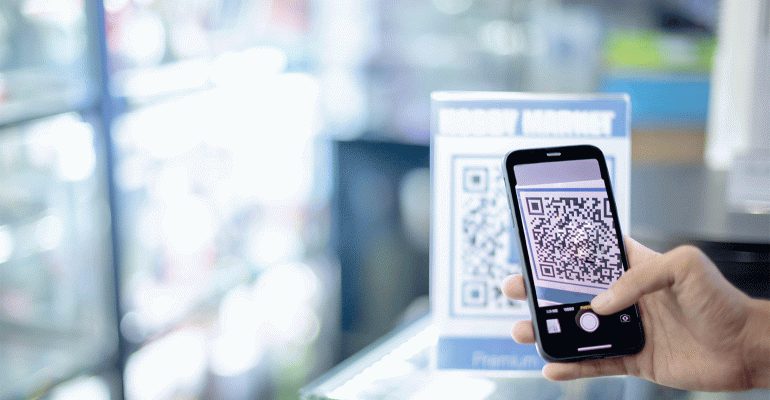QR codes, which were once a punchline in the media world, are now important tools for driving restaurants’ growth and enhancing the guest experience, enabling dynamic menus that allow restaurant operators to avoid wasting time and budget on printing menus and testing new pricing. They also represent how mobile will be central to the future of dining after two years of restaurants showing resiliency and constantly adapting to the new realities.
The public safety measures around the pandemic brought the QR code back from the abyss, and the momentum stands to continue: Insider Intelligence forecasts that QR code scanning will lift year-over-year by 10% in 2022, following a jump of 15% last year and 25% in 2020. And 68% of adults say they are likely to pay using contactless or mobile payment options if the restaurant offers them. After falling out of favor in the 2010s, QR codes are perhaps the best tech revival story of this young decade so far.
Across industry sectors and the general public, the ease of scanning QR codes is no longer an underappreciated feature — they are now as mainstream as watching TV. Coinbase created a lot of attention when it featured a QR code in its Super Bowl 56 ad — the crypto brand’s app downloads jumped 279% thanks to the commercial. Since then, brands such as Buick and Avocados From Mexico have used QR codes in their TV spots. Burger King was out in front of this trend in April 2020, giving out free Whoppers to customers who were able to scan a QR code using the BK mobile app during a 15-second TV ad. Now, it’s a trend that’s not going away.
For restaurants, some may believe that QR codes have merely served as stand-ins for traditional, tactile menus to avoid spreading germs during the pandemic. But QR codes represent how technology can transform the dining experience and be the catalyst for a new era of hospitality, benefitting restaurant guests with self-service ordering and checkout, employees with the ability to turn more tables and get more tips, and owners with more efficient staff and higher sales.
More control over the pace of the meal
Restaurants can use QR codes beyond providing access to mobile menus/ordering, as they can spur and improve in-person dining, better understand customer preferences with data, and provide greater convenience. QR codes enable self-service that allow the guest to order and pay on their own and create a more efficient experience across the front of the house.
By putting ordering and payment technology in the hands of guests, servers can focus on more rewarding roles, like welcoming guests, helping them choose the right menu items, checking in, and not having to spend time swiping credit cards. At the same time, diners can keep ordering food and drinks without having to worry about flagging down a server. It’s clearly a win-win –– digitizing the more cumbersome aspects of restaurant management creates a more positive experience for staff and guests alike.
What’s more, the ease of mobile menus/ordering seems to inspire guests to add more items to their tickets. For instance, Roc-N-Ramen has seen check sizes increase by 15% since first offering its mobile ordering via QR codes. Such an increase shows that, by using today’s technology, restaurants can significantly benefit from giving guests more control over the pace of their meal.
The power of guest data
We are entering an exciting new era of the dining experience via personalization. Thanks to QR codes and mobile menus/ordering, restaurants can introduce loyalty programs, customer rewards and specials that can help power the dining experience for the guests’ future visits.
A strong example of data that can be captured via mobile ordering platforms: Restaurants can immediately get guest feedback, asking patrons to quickly tap a button to rate their meal and guest experience. This real-time feedback empowers restaurant operators to show their commitment to the guest experience by promptly addressing both positive and negative reviews. Such timely responses to negative ratings are more important than ever — a Toast study found that 65% of one-star Yelp reviews were posted within one day of a poor dining experience.
Additionally, restaurant companies of all sizes — not just national chains — should be able to own their customer data. The data that can be collected via mobile ordering should be considered a high priority for all hospitality operators. Looking ahead, as more restaurants leverage their first-party data, the dining experience of the future will soon be personalized for each guest based on their past food and beverage purchases.
The data-powered personalization can go beyond past orders, though. Imagine being able to easily filter your menu by dietary restrictions or preferences such as gluten-free, peanut-free or dairy-free. Most everyone has dined with friends or family where there are dietary concerns, and the current experience at a restaurant is not great for such instances. In that regard, personalized menus empowered by digital technology can be a game-changer.
The future: more tech and a better dining experience
QR codes’ reemergence represents only a jumping-off point for the technological transformation of the dining experience. In fact, QR codes could go away if near field communications (NFC) technology takes off, allowing restaurants to offer guests and passersby the chance to tap NFC-enabled smart menus and signage. In those cases, guests could receive helpful details such as hours of business, menu options, and even wait times and seating availability.
Also, in the not-so-distant future, we’ll see innovation around the dining experience before the guest arrives. I predict we’ll start to see restaurants offering the ability for guests to not only make a reservation online — which is already happening widely — but also to select a specific table location in the establishment and order their drinks and appetizers ahead of time so the items are waiting for them as they sit down. These ideas represent where the industry is headed, embarking on an “End of Waiting” period.
Especially in fast-casual and quick-service concepts, diners will come to expect these self-service options because they can deliver a better experience. Mobile ordering, in other words, has become a need-to-have technology instead of a nice-to-have idea. And someday, the restaurant industry will look back at the meshing of traditional hospitality with tech-powered self-service and point to QR codes as the feature that ushered in a new era.
AUTHOR BIO
 Steve Fredette is president, cofounder and a director of Toast, where he leads product and innovation initiatives. Prior to Toast, he worked on mobile app development before the iPhone came out, creating the first Flickr and Shoebuy.com apps. In his career spanning two decades, Steve also helped build up Endeca’s business in various roles before it sold to Oracle for $1.1 billion.
Steve Fredette is president, cofounder and a director of Toast, where he leads product and innovation initiatives. Prior to Toast, he worked on mobile app development before the iPhone came out, creating the first Flickr and Shoebuy.com apps. In his career spanning two decades, Steve also helped build up Endeca’s business in various roles before it sold to Oracle for $1.1 billion.

